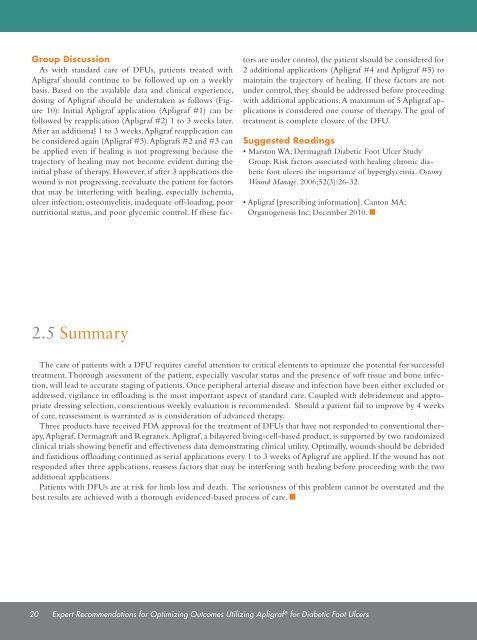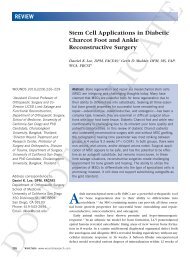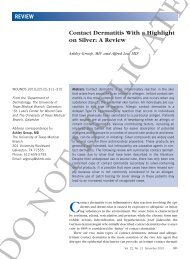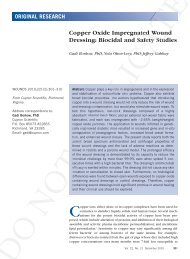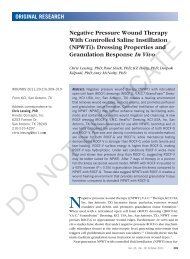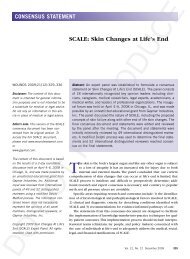Expert Recommendations for Optimizing Outcomes ... - Wounds
Expert Recommendations for Optimizing Outcomes ... - Wounds
Expert Recommendations for Optimizing Outcomes ... - Wounds
Create successful ePaper yourself
Turn your PDF publications into a flip-book with our unique Google optimized e-Paper software.
Group Discussion<br />
As with standard care of DFUs, patients treated with<br />
Apligraf should continue to be followed up on a weekly<br />
basis. Based on the available data and clinical experience,<br />
dosing of Apligraf should be undertaken as follows (Figure<br />
10): Initial Apligraf application (Apligraf #1) can be<br />
followed by reapplication (Apligraf #2) 1 to 3 weeks later.<br />
After an additional 1 to 3 weeks, Apligraf reapplication can<br />
be considered again (Apligraf #3). Apligrafs #2 and #3 can<br />
be applied even if healing is not progressing because the<br />
trajectory of healing may not become evident during the<br />
initial phase of therapy. However, if after 3 applications the<br />
wound is not progressing, reevaluate the patient <strong>for</strong> factors<br />
that may be interfering with healing, especially ischemia,<br />
ulcer infection, osteomyelitis, inadequate off-loading, poor<br />
nutritional status, and poor glycemic control. If these factors<br />
are under control, the patient should be considered <strong>for</strong><br />
2 additional applications (Apligraf #4 and Apligraf #5) to<br />
maintain the trajectory of healing. If these factors are not<br />
under control, they should be addressed be<strong>for</strong>e proceeding<br />
with additional applications. A maximum of 5 Apligraf applications<br />
is considered one course of therapy. The goal of<br />
treatment is complete closure of the DFU.<br />
Suggested Readings<br />
• Marston WA; Dermagraft Diabetic Foot Ulcer Study<br />
Group. Risk factors associated with healing chronic diabetic<br />
foot ulcers: the importance of hyperglycemia. Ostomy<br />
Wound Manage. 2006;52(3):26-32.<br />
• Apligraf [prescribing in<strong>for</strong>mation]. Canton MA:<br />
Organogenesis Inc; December 2010. n<br />
2.5 Summary<br />
The care of patients with a DFU requires careful attention to critical elements to optimize the potential <strong>for</strong> successful<br />
treatment. Thorough assessment of the patient, especially vascular status and the presence of soft tissue and bone infection,<br />
will lead to accurate staging of patients. Once peripheral arterial disease and infection have been either excluded or<br />
addressed, vigilance in offloading is the most important aspect of standard care. Coupled with debridement and appropriate<br />
dressing selection, conscientious weekly evaluation is recommended. Should a patient fail to improve by 4 weeks<br />
of care, reassessment is warranted as is consideration of advanced therapy.<br />
Three products have received FDA approval <strong>for</strong> the treatment of DFUs that have not responded to conventional therapy,<br />
Apligraf, Dermagraft and Regranex. Apligraf, a bilayered living-cell-based product, is supported by two randomized<br />
clinical trials showing benefit and effectiveness data demonstrating clinical utility. Optimally, wounds should be debrided<br />
and fastidious offloading continued as serial applications every 1 to 3 weeks of Apligraf are applied. If the wound has not<br />
responded after three applications, reassess factors that may be interfering with healing be<strong>for</strong>e proceeding with the two<br />
additional applications.<br />
Patients with DFUs are at risk <strong>for</strong> limb loss and death. The seriousness of this problem cannot be overstated and the<br />
best results are achieved with a thorough evidenced-based process of care. n<br />
20 <strong>Expert</strong> <strong>Recommendations</strong> <strong>for</strong> <strong>Optimizing</strong> <strong>Outcomes</strong> Utilizing Apligraf ® <strong>for</strong> Diabetic Foot Ulcers


